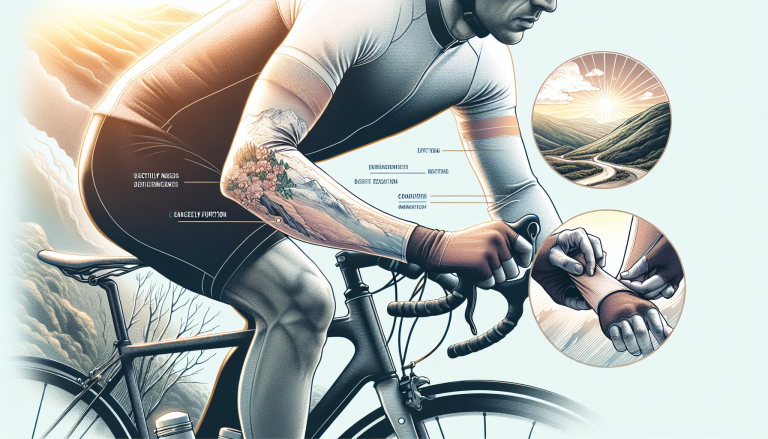Have you ever wondered how the cycling demographic differs across various regions in the UK? From the bustling streets of London to the serene countryside of Wales, the cycling culture is as diverse as the landscapes of this beautiful nation. In this article, we will explore the intriguing variations in cycling demographics across different regions, uncovering trends and insights that shed light on the unique preferences and habits of cyclists across the UK. So hop on your bike and join us on this fascinating journey through the cycling world of the UK!
Table of Contents
ToggleCycling Demographic in London
Cycling Infrastructure and Commuting
In London, cycling has become a popular mode of transportation due to the city’s efforts to improve cycling infrastructure. With the implementation of dedicated cycling lanes, bike storage facilities, and improved intersection safety measures, commuting by bike has become more convenient and safer. This has attracted a diverse range of commuters, including professionals, students, and even families, who find cycling an efficient and eco-friendly way to get around the city.
Cycling Clubs and Events
London is also home to a vibrant cycling community, with numerous clubs and events catering to cyclists of all levels. From casual weekend rides to competitive races, cyclists in London have plenty of opportunities to connect with fellow enthusiasts and explore the city’s beautiful surroundings. These clubs and events not only foster a sense of camaraderie but also provide a platform for cyclists to improve their skills and share their passion for cycling.
Bike-sharing Programs
To further encourage cycling in the city, London boasts several bike-sharing programs, such as Santander Cycles and Lime Bike, which provide convenient access to bicycles for short-term rentals. These programs have proven to be particularly popular among tourists and occasional cyclists who may not own a bike but still want to explore the city on two wheels. With docking stations scattered throughout the city, bike-sharing programs have made cycling an accessible and affordable option for many.
Bicycle Ownership
While bike-sharing programs have gained popularity in London, bicycle ownership remains significant among the cycling demographic. Many Londoners, especially those who cycle frequently, choose to invest in their own bikes. This allows them to have personalized and suitable equipment for their cycling needs, whether it’s for commuting, leisure rides, or even long-distance touring. The availability of a wide range of bike shops and cycling experts in London makes it easier for cyclists to find the perfect bike and accessories to enhance their riding experience.
Cycling Awareness and Education Programs
In order to promote safer cycling practices and increase public awareness about the benefits of cycling, various organizations and government initiatives in London have been focusing on cycling education and awareness programs. These initiatives aim to teach cyclists about road safety, proper bicycle maintenance, and advocacy for cycling-friendly policies. By educating both cyclists and motorists, London is striving to create a harmonious and inclusive environment for all road users.
Cycling Demographic in the South East
Community Cycling Initiatives
The South East region of the UK has seen a rise in community-based cycling initiatives that aim to engage and involve residents of all ages and backgrounds. From cycling clubs to community-led events, these initiatives provide a platform for individuals to come together, share their love for cycling, and create a sense of community. These initiatives not only encourage participation in cycling but also foster a healthier and more active lifestyle among residents.
Cycling Tourism and Attractions
The South East region boasts various cycling tourism opportunities, with its picturesque countryside, historic landmarks, and charming towns. Cyclists from all over the country, and even abroad, visit the region to explore iconic attractions such as the White Cliffs of Dover, Canterbury Cathedral, and the stunning South Downs National Park. These cycling routes and attractions not only showcase the natural beauty of the region but also contribute to the local economy through tourism.
Rural vs Urban Cycling
One noticeable aspect of the cycling demographic in the South East is the difference in cycling preferences between rural and urban areas. While urban cycling is more common in busy cities like Brighton and Canterbury, rural areas such as the Kent countryside attract cyclists looking for scenic routes and peaceful rides. This diversifies the cycling demographic in the region and caters to a wide range of cycling preferences.
Participation in Cycling Sports
The South East region has also seen a rise in participation in cycling sports, with a growing number of individuals taking part in races, time trials, and endurance events. Cycling clubs and organizations in the region offer training programs and support for those interested in competitive cycling, contributing to the development of a dynamic and competitive cycling scene. The region has also produced talented cyclists who have gone on to achieve success at national and international levels.
Cycling Infrastructure Investments
To further support and promote cycling in the South East region, local authorities and governments have been investing in cycling infrastructure. This includes the creation of cycling lanes, improved signage, and the establishment of dedicated cycling hubs and facilities. These investments aim to make cycling safer and more accessible, encouraging residents and visitors alike to choose cycling as a mode of transportation or leisure activity.
Cycling Demographic in the South West
Coastal Cycling Paths and Routes
The South West region of the UK offers stunning coastal cycling paths and routes, making it a popular destination for cyclists. From the iconic Land’s End to the scenic Jurassic Coast, cyclists can enjoy breathtaking views of the sea and explore charming coastal towns. These routes attract both local residents and tourists who are drawn to the region’s natural beauty and the opportunity to experience the coastal landscape on two wheels.
Cycling Holidays and Tours
Cycling holidays and tours are a popular choice for cyclists visiting the South West region. Tour companies offer guided cycling tours, providing cyclists with the opportunity to explore the region’s diverse landscapes, historical sites, and local culture. These tours cater to cyclists of different abilities and interests, ensuring that everyone can find a cycling holiday that suits their preferences.
Cycling in National Parks
The South West region is home to several national parks, including Dartmoor, Exmoor, and the New Forest, which offer fantastic cycling opportunities. Cyclists can venture through vast expanses of moorland, dense woodlands, and rolling hills, immersing themselves in the region’s natural beauty. National parks provide a unique cycling experience, allowing cyclists to connect with nature while enjoying the physical and mental benefits of cycling.
Cycling for Health and Wellbeing
Cycling in the South West is not just about recreation and tourism; it also plays a significant role in promoting health and wellbeing. Many residents in the region use cycling as a means to stay active, improve their fitness, and enhance their overall well-being. Local authorities and health organizations have recognized the benefits of cycling and have implemented programs to encourage residents to incorporate cycling into their daily routines.
Cycling Infrastructure Challenges
While the South West region offers exceptional cycling experiences, there are challenges when it comes to cycling infrastructure. The rural nature of the area, with its winding roads and hilly terrain, can pose challenges for cyclists. Narrow roads and limited cycling lanes can make it more difficult for cyclists to navigate and share the road safely with other vehicles. However, efforts are being made to improve cycling infrastructure in the region, with plans for new cycling routes and upgraded facilities in the pipeline.
Cycling Demographic in the Midlands
Cycling to Work Initiatives
In the Midlands, cycling to work initiatives have gained traction, encouraging individuals to choose cycling as their preferred mode of commuting. Employers and local authorities have partnered to provide incentives such as cycle-to-work schemes, secure bike storage, and shower facilities at workplaces. These initiatives not only promote active lifestyles but also contribute to reducing traffic congestion and improving air quality in urban areas.
Cycling and Student Communities
With several universities and higher education institutions, the Midlands region has a significant student population, many of whom embrace cycling as a mode of transportation and recreation. Students often opt for cycling as an affordable and convenient way to navigate around campus and explore the surrounding areas. This has led to the establishment of cycling-focused student communities, creating a supportive network for student cyclists and promoting cycling as a sustainable transportation option.
Cycling in Historic Cities
The Midlands is home to several historic cities, including Birmingham, Nottingham, and Coventry. These cities offer unique and charming settings for cycling, with their historic architecture, cultural landmarks, and vibrant atmosphere. Many cyclists in the Midlands enjoy exploring the city streets and cycling along designated cycling paths, which often pass by historical sites and iconic landmarks. Cycling in these cities allows cyclists to immerse themselves in the region’s rich history while enjoying the benefits of active transportation.
Cycling Infrastructure Development
With the growing popularity of cycling in the Midlands, there has been a focus on developing cycling infrastructure to support cyclists. Local authorities have invested in the creation of dedicated cycle lanes, improved signage, and cycle-friendly road designs. These developments not only enhance the safety of cyclists but also encourage more individuals to take up cycling as a means of transportation and leisure.
Cycling Safety and Awareness
Promoting cycling safety and awareness is a key aspect of the cycling demographic in the Midlands. Local organizations and authorities actively work towards educating cyclists about road safety, providing cycling proficiency training, and advocating for cyclist-friendly policies. This focus on safety and awareness ensures that cyclists have the knowledge and skills to navigate the roads confidently while promoting a culture of mutual respect between cyclists and other road users.
Cycling Demographic in the North West
Industrial Heritage Cycling Routes
The North West region of the UK is renowned for its rich industrial heritage, and cyclists have embraced the opportunity to explore this history through designated cycling routes. These routes often pass through former industrial sites, canals, and railways, allowing cyclists to immerse themselves in the region’s industrial past. This unique combination of heritage and cycling appeals to history enthusiasts and avid cyclists alike.
Cycling for Social Causes and Fundraising
Cycling for social causes and fundraising has gained popularity among the cycling demographic in the North West. Charity rides and fundraising events provide an avenue for cyclists to combine their passion for cycling with their desire to make a positive impact in their communities. These events not only raise funds for charitable organizations but also promote the spirit of giving and community involvement among cyclists.
Mountain Biking Trails
The North West region offers diverse terrain, making it an ideal destination for mountain biking enthusiasts. With a multitude of challenging trails and rugged landscapes, cyclists can enjoy an adrenaline-filled experience in areas such as the Lake District and the Peak District. Mountain biking attracts individuals who seek adventure and thrill on their bikes, contributing to the diversity of the cycling demographic in the region.
Cycling in Manchester and Liverpool
The cities of Manchester and Liverpool are known for their vibrant cultural scenes, and cycling plays an integral part in these cities. Both cities have seen significant investments in cycling infrastructure, including dedicated cycling lanes, bike-sharing schemes, and bike-friendly facilities. Manchester’s cycling culture is further enhanced by the presence of Velodrome, which has hosted major cycling events. These developments have nurtured a strong cycling community, with residents and visitors alike embracing cycling as a practical and enjoyable mode of transport.
Cycling Infrastructure in Urban Centers
The North West region, with its bustling urban centers, faces challenges when it comes to cycling infrastructure. The presence of busy roads and congested streets can make cycling less accessible and less safe. However, efforts are being made to improve cycling infrastructure in urban areas, with local authorities investing in cycle lanes, bike parking facilities, and traffic management measures. These developments aim to encourage more individuals to cycle in urban centers, promoting active lifestyles and reducing reliance on private vehicles.
Cycling Demographic in the North East
Cycling in Newcastle and Durham
The North East region is home to vibrant cities such as Newcastle and Durham, where cycling has gained popularity as a preferred mode of transportation. Both cities have made efforts to improve cycling infrastructure, including the creation of cycling lanes and bike-friendly facilities. These initiatives have fostered a cycling-friendly environment, attracting residents and visitors to explore the cities on two wheels while enjoying the beautiful architecture and cultural heritage.
Cycling in Rural Yorkshire
Rural Yorkshire offers cyclists stunning landscapes and picturesque villages, making it a popular destination for cycling enthusiasts. Cyclists can traverse rolling hills, expansive moorlands, and charming countryside, taking in the region’s natural beauty. The peaceful and serene environment appeals to those seeking a slower-paced cycling experience away from busy urban areas.
Cycling in National Parks and Forests
The North East region is home to several national parks, including Northumberland National Park and the North York Moors, which provide excellent cycling opportunities. These parks offer designated cycling routes that allow cyclists to explore the region’s diverse ecosystems and enjoy the tranquility of nature. Cycling in national parks and forests provides a unique experience, allowing cyclists to connect with the natural environment and experience the region’s biodiversity up close.
Community-Led Cycling Initiatives
Community-led cycling initiatives have played a significant role in promoting cycling in the North East region. These initiatives bring together residents, schools, and local organizations to organize cycling events, bike repair workshops, and cycling proficiency training. By focusing on community engagement, these initiatives aim to create a cycling culture that is inclusive and accessible to all, regardless of age or cycling ability.
Cycling Infrastructure Investments
To support the growing cycling demographic in the North East, investments have been made in cycling infrastructure. Local authorities have introduced cycling-friendly measures such as improved signage, designated cycling lanes, and secure bike storage facilities. These developments aim to make cycling safer and more enjoyable, encouraging more residents and visitors to embrace cycling as a mode of transportation and recreation.
Cycling Demographic in Wales
Coastal and Mountain Cycling Routes
Wales offers cyclists a diverse range of cycling routes, from stunning coastal paths to challenging mountain trails. Cyclists can enjoy breathtaking views of the sea, explore secluded coves, and tackle the mountains and valleys of Snowdonia, Brecon Beacons, and Pembrokeshire. The plethora of cycling routes attracts cyclists of all abilities, ensuring that there is something for everyone to enjoy in Wales.
Cycling in Cardiff and Swansea
The cities of Cardiff and Swansea have made significant efforts to promote cycling as a sustainable mode of transportation. Both cities have invested in cycling infrastructure, including the creation of cycle lanes, bike-sharing schemes, and secure bike parking facilities. Cardiff and Swansea also host cycling events and initiatives that aim to engage residents and encourage them to choose cycling as a means of getting around the cities.
Cycling for Sustainable Tourism
Wales has recognized the potential of cycling as a sustainable tourism activity and has been actively promoting cycling tourism. The country offers a wide range of cycling holidays and tours that showcase its stunning landscapes, historical landmarks, and rich cultural heritage. Cycling tourists in Wales can experience the charm of rural villages, explore ancient castles, and immerse themselves in the peaceful countryside. By promoting cycling for sustainable tourism, Wales aims to attract visitors who appreciate environmentally friendly travel options.
Cycling Infrastructure Challenges
While Wales offers exceptional cycling experiences, there are challenges when it comes to cycling infrastructure. The mountainous terrain and rural nature of many parts of Wales present obstacles in developing cycling-friendly infrastructure. Narrow roads, limited cycling lanes, and steep inclines can make cycling more challenging, particularly for less experienced cyclists. However, efforts are being made to improve cycling infrastructure, with investments in new cycling routes and the enhancement of existing facilities.
Cycling Clubs and Organizations
Wales has a vibrant cycling community, with numerous clubs and organizations catering to cyclists of all ages and abilities. These clubs provide a platform for cyclists to connect, share their passion, and participate in organized rides and events. From leisurely group rides to competitive races, these clubs foster a sense of camaraderie among cyclists and contribute to the growth of the cycling community in Wales.
Cycling Demographic in Scotland
Cycling the Highlands and Islands
Scotland’s Highlands and Islands offer cyclists a unique and awe-inspiring experience. Cyclists can explore remote and rugged landscapes, passing by lochs, mountains, and picturesque villages. The region’s breathtaking scenery attracts cyclists from around the world, who seek to challenge themselves and immerse themselves in the beauty of nature. Cycling in the Highlands and Islands can be a solitary and reflective experience, allowing cyclists to connect with the region’s wild and untouched surroundings.
Cycling in Edinburgh and Glasgow
The cities of Edinburgh and Glasgow have seen a surge in cycling popularity in recent years. Both cities have invested in improving cycling infrastructure, with the creation of cycle lanes, bike-sharing schemes, and cycling-friendly facilities. Glasgow has also established a network of off-road cycle routes that connect various parts of the city, encouraging residents and visitors alike to cycle for both transportation and recreation. Cycling has become an integral part of these cities’ identities, reflected in the numerous cycling events and festivals they host.
Cycling for Adventure Tourism
Scotland has become a sought-after destination for adventure tourism, and cycling plays a significant role in this industry. Cyclists can embark on challenging mountain biking trails, conquer long-distance cycling routes, or take part in endurance events such as the famous North Coast 500. Adventure cyclists are drawn to Scotland for its rugged terrain, dramatic landscapes, and the sense of adventure that comes with exploring undiscovered paths and wild regions.
Cycling Infrastructure Development
Scotland has been actively investing in cycling infrastructure to support and encourage cycling across the country. National and local authorities have been working towards creating a comprehensive network of cycling routes, both on and off-road. From urban cycling lanes to rural cycling paths, these developments aim to make cycling safer and more accessible to residents and visitors alike.
Cycling Events and Festivals
Scotland is renowned for its cycling events and festivals, which attract cyclists of all levels and interests. From the iconic Tour of Britain to the exhilarating Scottish Six Days Trial, these events showcase the country’s cycling culture and provide a platform for cyclists to challenge themselves and compete against fellow enthusiasts. Cycling festivals, such as the Pedal for Scotland event, offer a range of activities and rides for cyclists of all abilities, celebrating the joy of cycling and fostering a sense of community among participants.
Cycling Demographic in Northern Ireland
Cycling the Causeway Coast
Northern Ireland’s Causeway Coast offers cyclists a breathtaking experience, with its stunning coastal scenery and historic landmarks. Cycling along the Causeway Coast allows cyclists to explore iconic sites such as the Giant’s Causeway, Carrick-a-Rede Rope Bridge, and Dunluce Castle. The region’s diverse landscapes and rugged coastline provide an exhilarating backdrop for cyclists, attracting both local residents and tourists to venture on two wheels.
Cycling in Belfast and Derry
The cities of Belfast and Derry have embraced cycling as a sustainable mode of transportation. Both cities have invested in cycling infrastructure, including the creation of cycle lanes, bike-sharing schemes, and bike-friendly facilities. In Belfast, the Cathedral Quarter Cycling Club has grown in popularity, providing a community hub for cyclists to connect, share their experiences, and participate in organized rides. In Derry, the cycling community has rallied together to promote cycling-friendly initiatives and cycling culture throughout the city.
Cycling for Heritage Tourism
Cycling has become an integral part of heritage tourism in Northern Ireland, allowing visitors to immerse themselves in the region’s rich history and cultural heritage. From cycling tours of Belfast’s iconic murals to exploring the ancient ruins of Navan Fort in Armagh, cyclists can combine their love for outdoor activities with an appreciation for cultural landmarks. By promoting cycling for heritage tourism, Northern Ireland aims to attract visitors who seek an authentic and immersive experience.
Cycling Infrastructure Challenges
While Northern Ireland offers exceptional cycling experiences, there are challenges when it comes to cycling infrastructure. Narrow roads, limited cycle lanes, and busy traffic can make cycling less safe and less accessible, particularly in urban areas. However, the Northern Ireland government has recognized the importance of improving cycling infrastructure and has implemented plans to enhance cycling facilities and create designated cycling routes.
Cycling Community Engagement
Community engagement plays a vital role in the cycling demographic in Northern Ireland. Local cycling organizations and community groups work together to promote the benefits of cycling, provide cycling training, and organize events that bring cyclists together. As a result, a strong sense of community has developed among cyclists in Northern Ireland, with individuals supporting and inspiring each other to embrace cycling as a lifestyle choice.
Cycling Demographic in the Channel Islands
Scenic Coastal Cycling Routes
The Channel Islands, with their stunning coastline, offer cyclists picturesque coastal routes that showcase the beauty of the islands. Cyclists can enjoy sweeping sea views, visit secluded coves, and explore charming villages along the coastline. The tranquility and natural beauty of the Channel Islands make it an idyllic destination for cyclists looking for a peaceful and scenic cycling experience.
Cycling in Guernsey and Jersey
Cycling plays a significant role in the culture and lifestyle of Guernsey and Jersey. Both islands have embraced cycling as a sustainable mode of transportation, investing in cycling infrastructure and promoting cycling-friendly policies. Residents and visitors alike enjoy cycling around the islands, taking advantage of the well-maintained cycling routes and the stunning landscapes that surround them. Cycling has become an essential part of the islands’ identity, contributing to a healthier and more eco-friendly way of living.
Cycling for Sustainable Transportation
As small islands, Guernsey and Jersey prioritize sustainable transportation, and cycling is an integral part of this vision. The implementation of cycling-friendly infrastructure and the establishment of cycling lanes and routes contribute to reducing traffic congestion and promoting active travel. The compact nature of the islands makes cycling a practical and convenient choice for residents and visitors, supporting a greener and more sustainable way of getting around.
Cycling Infrastructure Development
Guernsey and Jersey have made significant investments in developing cycling infrastructure to accommodate the growing cycling demographic. The islands have introduced cycle lanes, bike-friendly facilities, and dedicated cycling paths, ensuring that cyclists have a safe and enjoyable experience. Ongoing efforts to improve and expand cycling infrastructure demonstrate the commitment of the Channel Islands to fostering a cycling-friendly environment.
Cycling Events and Festivals
Guernsey and Jersey are known for their vibrant cycling events and festivals, which attract cyclists from near and far. From family-friendly rides to challenging races, these events offer an opportunity for cyclists to come together, celebrate the joy of cycling, and showcase the islands’ passion for the sport. Cycling festivals also provide a platform to promote cycling as a healthy and inclusive activity, encouraging more individuals to take up cycling as a means of recreation and transportation.
In conclusion, the cycling demographic in the UK varies across different regions due to factors such as geography, infrastructure, culture, and community engagement. From the bustling streets of London to the picturesque landscapes of Scotland, each region offers unique opportunities and challenges for cyclists. Efforts to improve cycling infrastructure, promote cycling culture, and encourage community involvement have contributed to the growing popularity of cycling in the UK. As the benefits of cycling become more widely recognized, the cycling demographic will continue to evolve and flourish in diverse and exciting ways throughout the country.






